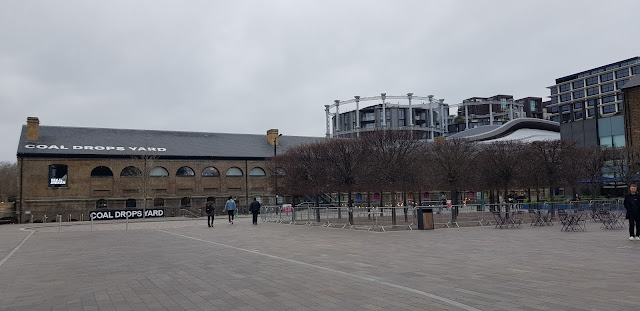 |
| Granary Square, looking towards Coal Drops buildings. |
Walking along the Regent's Canal from St John's Wood station Keilyn and I ended up at Coal Drops Yard, King's Cross. This historic area of London has gone through a major overhaul and is fast becoming one of the top destinations in the area.
 |
| Coal Drops Yard |
The entire area is a wonderful place to explore. From shops and restaurants, to bars and cafes and boutique retail outlets. The coal drops and the square, which incorporates a water feature that is wonderfully lit with coloured lights, gets a lot of use in warm weather.
 |
| The Fish and Coal buildings, now known as The Coal Office. |
And we explored most of it. Keilyn, obviously, was more interested in exploring the water feature, but without getting too wet.
A terraced seating area allows for people to sit by the calm water, on summer's evenings, to enjoy the peace or, perhaps, catch a movie at the pop-up cinema.
 |
| Keilyn in the water feature. |
The entire area is split into five distinct area: Canopy Market, Coal Drops Yard, Gasholder Park, Granary Square and Lewis Cubitt Park.
Brief History
King's Cross has always been of strategic importance and has gone through many transformations over the years.
When the Regent's Canal was completed, in 1820, King's Cross became linked to the major industrial cities of the north, enabling goods and industry to be brought to the capital.
But it was the arrival of the railways that turned the area into the important hub that it would become. Everything from grain and potatoes to coal and other industrial commodities came via King's Cross to be used in the area or transferred on.
With the completion of Regent’s Canal in 1820, King’s Cross was linked to the industrial cities in the north, bringing both goods and industry to the area.
Following World War II King's Cross and the surrounding area went into decline, with many of the buildings lying derelict, railway sidings empty and contaminated land everywhere.
King's Cross had always been known for its nightlife and its artistic scene, but crime, unemployment an poverty were the new 'norm' for the area.
During the late 20th Century the decision was made to move the Channel Tunnel Rail Link to St Pancras from Waterloo. This made the idea of rejuvenating the area much more appealing to the landowners and businesses in the area.
Following years of studies and consultations a plan was put in place that would redevelop the entire area.
In 2006 work began on the creation of 50 new buildings, 20 new streets, 10 new major public spaces, the restoration and refurbishment of 20 historic buildings and structures, and up to 2,000 homes.
In 2011 the Granary Building became hoe to the University of the Arts London and various areas of the development opened to the public. The Coal Drops Yard were turned into a shopping area with food and retail outlets.
Other companies to move to the area include the Great Northern Hotel, Google, Facebook and Universal Music, to name but a few.
With its new public streets, squares, gardens, fountains in Granary Square, Lewis Cubitt Park, Gasholder Park and Canal-side seating, King’s Cross is now a wonderful place to visit.
No comments:
Post a Comment